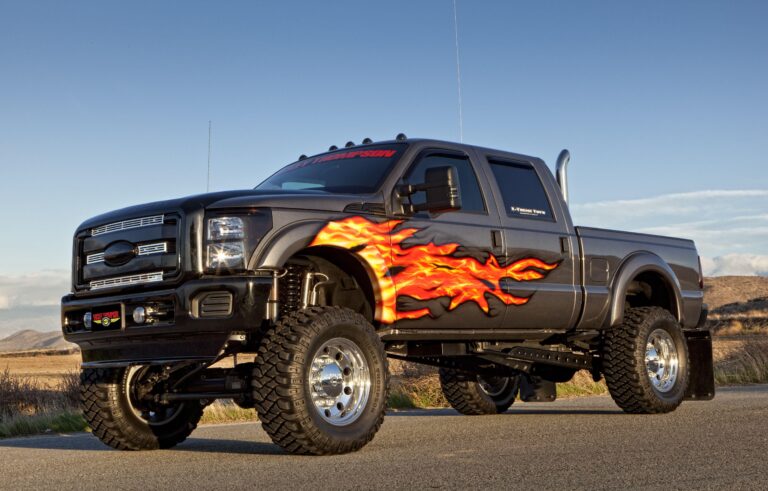Utility Trucks For Sale California: Your Comprehensive Guide to Finding the Right Workhorse
Utility Trucks For Sale California: Your Comprehensive Guide to Finding the Right Workhorse cars.truckstrend.com
California, a state renowned for its sprawling landscapes, diverse industries, and dynamic economy, is a hotbed of activity for businesses and individuals alike. From the fertile farmlands of the Central Valley to the bustling construction sites of Los Angeles and the meticulously maintained green spaces of Silicon Valley, a common thread weaves through these varied endeavors: the indispensable utility truck. More than just a vehicle, a utility truck is a specialized tool, a mobile workshop, and an essential asset for countless operations across the Golden State.
This comprehensive guide, "Utility Trucks For Sale California," aims to be your definitive resource for navigating this unique market. Whether you’re a seasoned contractor looking to expand your fleet, a budding entrepreneur in need of a reliable workhorse, or a utility company aiming to enhance operational efficiency, understanding the nuances of acquiring the right utility truck in California is paramount. We’ll delve into everything from the different types available and crucial buying considerations to the specific regulatory landscape and where to find the best deals, ensuring you make an informed and strategic investment.
Utility Trucks For Sale California: Your Comprehensive Guide to Finding the Right Workhorse
What Defines a Utility Truck?
At its core, a utility truck is a vehicle designed and equipped for specific professional tasks beyond simple transportation. Unlike standard pickup trucks, which primarily offer open bed hauling, utility trucks are often customized with specialized bodies, compartments, and equipment tailored to the needs of various trades. These modifications enhance functionality, organization, and safety, transforming a basic chassis into a highly efficient mobile workspace.
Common features that distinguish utility trucks include:
- Service/Utility Bodies: Enclosed compartments with shelving and drawers for tools, parts, and equipment.
- Flatbeds: Open platforms for hauling large, irregularly shaped items, often with stake sides for retention.
- Dump Bodies: Hydraulically lifted beds for easy unloading of loose materials like dirt, gravel, or debris.
- Aerial Devices (Boom/Bucket Trucks): Extendable booms or articulating arms with buckets for working at height.
- Cranes: Mounted cranes for lifting and moving heavy objects.
- Specialized Tanks: For water, fuel, or other liquids.

The versatility of these configurations makes utility trucks indispensable across a wide spectrum of industries, directly impacting productivity and operational capability.
Why Buy a Utility Truck in California? The Golden State Advantage
California’s unique economic and environmental landscape makes the utility truck market particularly vibrant and distinct. Here’s why acquiring the right utility truck is critical for success in the state:
- Diverse Industrial Demand: California’s economy spans agriculture, construction, landscaping, telecommunications, energy, and municipal services. Each sector relies heavily on specialized utility vehicles to perform daily tasks efficiently and safely.
- Operational Efficiency: A well-equipped utility truck reduces travel time for tools and materials, improves on-site organization, and minimizes downtime, directly boosting productivity and profitability.
- Enhanced Safety: Purpose-built utility trucks often feature integrated safety mechanisms, secure storage for hazardous materials, and better ergonomics, reducing the risk of accidents and injuries on the job.
- Compliance with Regulations: California has some of the strictest environmental and vehicle regulations in the nation, particularly concerning emissions (CARB – California Air Resources Board). Owning a compliant utility truck is not just good practice; it’s a legal necessity. Investing in newer, compliant models or understanding retrofit options for older vehicles is crucial.
- Long-Term Investment: A robust utility truck is a significant asset that can serve a business for many years, providing a strong return on investment through increased operational capacity and reduced outsourcing costs.

Types of Utility Trucks Commonly Found in California
The utility truck market in California offers a wide array of options, each designed for specific functions:
- Service/Mechanic Trucks: Perhaps the most common, these trucks feature enclosed side compartments for organized storage of tools, parts, and equipment. Ideal for mobile mechanics, plumbers, electricians, and general contractors.
- Flatbed Trucks: Versatile for hauling large, bulky items that won’t fit in a traditional bed. Often used in construction, landscaping, and material delivery. Some include stake sides for load containment.
- Dump Trucks: Essential for construction, landscaping, and waste management, these trucks feature a hydraulically lifted bed for efficient unloading of loose materials. Available in various sizes, from light-duty to heavy-duty.
- Bucket Trucks/Boom Trucks: Crucial for utility companies, tree services, and sign installation, allowing workers to safely reach elevated areas for maintenance, repair, or construction.
- Crane Trucks: Equipped with a mounted crane, these are used for lifting and placing heavy materials or equipment on job sites, common in construction and heavy-duty mechanical work.
- Water Trucks: Used for dust control on construction sites, agricultural irrigation, or fire suppression, featuring large water tanks and spray nozzles.
- Chipper Trucks: Specifically designed for tree care and landscaping, often paired with a wood chipper to transport and dispose of tree branches and debris.
- Refrigerated Trucks: For transporting perishable goods, common in food service and specialized delivery.
The choice of truck type will depend entirely on your specific industry and operational needs.
Key Considerations When Buying a Utility Truck in California
Purchasing a utility truck, especially in California, requires careful consideration of several factors to ensure you make the best investment for your business.
- Budget: New vs. Used:
- New Trucks: Offer the latest technology, full warranties, and immediate CARB compliance. Higher upfront cost.
- Used Trucks: Significantly lower purchase price, making them attractive for startups or smaller budgets. However, they may require more maintenance, and CARB compliance becomes a critical factor.
- Specific Job Requirements:
- Payload and Towing Capacity: Ensure the truck can handle the weight of your tools, equipment, and materials, plus any trailers you plan to tow.
- Specialized Equipment Needs: Do you need a crane, a lift gate, a specific type of service body, or a power inverter?
- Terrain and Driving Conditions: Will the truck operate on rough terrain (4×4 might be necessary) or primarily on paved roads?
- Vehicle Condition (Especially for Used Trucks):
- Engine and Transmission: These are the heart of the truck. Look for smooth operation, no unusual noises, and proper fluid levels.
- Frame and Body: Check for rust, cracks, or significant damage, especially on the frame, which can compromise safety and structural integrity.
- Specialized Equipment: Thoroughly test all hydraulic systems, cranes, buckets, and power take-offs (PTOs) to ensure they are in good working order.
- Maintenance Records: A complete service history is invaluable for understanding how well the truck has been maintained.
- Emissions Regulations (California CARB Compliance): This is perhaps the most critical unique consideration for California buyers.
- The California Air Resources Board (CARB) has stringent regulations for diesel-powered vehicles, especially older ones. Trucks must meet specific emissions standards, often requiring Diesel Particulate Filters (DPFs) and Diesel Exhaust Fluid (DEF) systems.
- Before purchasing any used diesel utility truck, verify its CARB compliance. An older, non-compliant diesel truck may be illegal to operate in California or require expensive retrofits. Check the TRUCRS database or consult with a CARB representative.
- Gasoline trucks typically face fewer CARB restrictions but may have higher fuel costs depending on usage.
- Fuel Type:
- Diesel: Known for torque, fuel efficiency (especially under load), and longevity, but higher purchase price and strict CARB regulations.
- Gasoline: Lower upfront cost, less stringent emissions regulations, but generally lower fuel efficiency for heavy hauling.
- Alternative Fuels (CNG, Electric): Emerging options offering environmental benefits and potential incentives, but limited availability and higher initial cost.
- Maintenance & Parts Availability: Consider the ease and cost of maintaining the specific make and model, especially for specialized equipment. Are parts readily available in California?
- Resale Value: How well does the particular make and model hold its value? This is important if you plan to upgrade in the future.
Where to Find Utility Trucks For Sale in California
Finding the right utility truck involves knowing where to look and how to approach each source.
- Authorized Dealerships (New & Used):
- Pros: Access to new models, warranties, financing options, certified pre-owned programs, and often specialized service departments.
- Cons: Generally higher prices.
- Examples: Commercial truck dealerships like Freightliner, International, Ford Commercial, and specific utility truck dealers.
- Online Marketplaces:
- Commercial Truck Specific Sites: TruckPaper.com, CommercialTruckTrader.com, MyLittleSalesman.com. These platforms specialize in heavy equipment and commercial vehicles, offering detailed listings.
- General Classifieds: Craigslist, Facebook Marketplace. Can offer good deals from private sellers but require extreme caution due to potential scams and lack of buyer protection.
- Auction Sites: GovPlanet.com (government surplus), Ritchie Bros. Auctioneers, IronPlanet. Offer a wide range of trucks, often at competitive prices, but buying "as-is" requires expert inspection.
- Fleet Sales & Auctions:
- Large companies, utility providers, and government agencies often sell off their older fleets. These trucks are typically well-maintained but might have high mileage. Check local government auction websites or contact fleet managers directly.
- Truck Brokers/Used Truck Lots:
- These businesses specialize in sourcing and selling used commercial vehicles. They can often help find specific types of trucks and may offer some level of inspection or limited warranty.
The Buying Process: A Step-by-Step Guide
Navigating the purchase process effectively can save you time, money, and headaches.
- Define Your Needs and Budget: Be specific about the type of work, required payload, and equipment. Establish a realistic budget, including not just the purchase price but also registration, insurance, and potential initial maintenance.
- Research and Identify Potential Trucks: Use online resources, visit dealerships, and attend auctions. Create a shortlist of trucks that meet your criteria.
- Inspect Thoroughly (or Hire an Inspector):
- Visual Inspection: Check for fluid leaks, tire wear, body damage, frame integrity, and general cleanliness.
- Mechanical Inspection: If buying used, strongly consider hiring a certified mechanic specializing in commercial vehicles for a pre-purchase inspection. This can uncover hidden issues.
- Specialized Equipment Check: Test every function of the boom, crane, dump bed, etc.
- Check CARB Compliance (Crucial for CA): Request CARB compliance documentation, engine serial numbers, and check the CARB TRUCRS database or contact CARB directly. Do not assume compliance; verify it.
- Test Drive: Drive the truck under various conditions, including some typical of your intended use. Listen for unusual noises, check braking, steering, and transmission shifts.
- Review Documentation: Examine the title (ensure it’s clear and matches the seller), maintenance records, and any warranties.
- Negotiate Price: Be prepared to negotiate. Research comparable sales to justify your offer.
- Secure Financing (If Needed): Obtain pre-approval from banks or credit unions, or explore dealer financing options.
- Complete Paperwork: Ensure all sales agreements are clear, and understand your obligations for sales tax, registration, and title transfer with the California DMV.
Financing Your Utility Truck Purchase
Acquiring a utility truck is a significant financial commitment. Here are common financing avenues:
- Bank Loans & Credit Unions: Traditional lenders often offer competitive rates for commercial vehicle loans.
- Equipment Financing Companies: Specialized lenders that focus solely on equipment financing. They may be more flexible with credit requirements for businesses.
- Dealership Financing: Many dealerships offer in-house financing or work with a network of lenders. This can be convenient but compare rates with external options.
- SBA Loans: Small Business Administration (SBA) loans can offer favorable terms for qualifying small businesses.
Prepare a solid business plan and financial statements to strengthen your loan application.
Maintenance Tips for Longevity (Post-Purchase)
Once you’ve acquired your utility truck, proactive maintenance is key to maximizing its lifespan and protecting your investment, especially in California where vehicle inspections and emissions standards are strict.
- Adhere to Manufacturer’s Schedule: Follow the recommended service intervals for oil changes, fluid checks, filter replacements, and general inspections.
- Regular Inspections: Beyond scheduled maintenance, conduct daily or weekly checks of tires, lights, fluid levels, and specialized equipment.
- Specialized Equipment Maintenance: Cranes, booms, hydraulic systems, and PTOs require their own specific maintenance routines. Keep them lubricated and inspect for wear and tear.
- CARB Compliance Maintenance: For diesel trucks, ensure DPFs are cleaned or regenerated as needed, and DEF levels are always topped up. Neglecting these can lead to costly repairs and regulatory fines.
- Keep Detailed Records: Maintain a comprehensive log of all maintenance, repairs, and inspections. This is crucial for troubleshooting, warranty claims, CARB compliance, and enhancing resale value.
Challenges and Solutions in the California Utility Truck Market
While the California market offers many opportunities, specific challenges exist:
- Challenge: CARB Compliance for Older Diesel Trucks.
- Solution: Focus your search on newer models (2010 and newer generally meet current standards), or explicitly look for trucks that have already undergone approved retrofits. For older trucks, verify their status with CARB directly before purchase. Consider gasoline-powered options if diesel regulations are too restrictive for your budget.
- Challenge: High Initial Cost.
- Solution: Explore the robust used truck market. While due diligence is critical for used vehicles, significant savings can be found. Also, thoroughly investigate financing and leasing options to manage cash flow.
- Challenge: Finding the Exact Specialized Truck.
- Solution: Be patient and broad in your search. Utilize truck brokers or specialized dealers who can source specific configurations. Sometimes, it’s more cost-effective to buy a basic chassis and then customize it with the desired utility body and equipment.
- Challenge: Risk of Scams or Misrepresentation (Especially Private Sales).
- Solution: Always conduct thorough inspections, get a vehicle history report (e.g., Carfax or similar commercial vehicle reports), and verify the seller’s identity and ownership. Never rush into a purchase.
Sample Price Table: Utility Trucks For Sale in California (Ranges)
Please note: Prices for utility trucks vary wildly based on make, model, year, mileage, condition, specific equipment, and market demand. This table provides general estimated ranges for trucks in good, operational condition in California and should be used as a guideline only. Always conduct thorough research and inspection before making a purchase.
| Truck Type / Class | New Price Range (Approx.) | Used Price Range (Good Condition, Approx.) | Key Features / Notes |
| :—————– | :————————- | :—————————————- | :—————————————————————————————————————————————————————————————————————————————————————————————————————————————————————————————————————————————————————————————————————————————————————————————————————————————————————————————————————————————————————————————————————————————————————————————————————————————————————————————————————————————————————————————————————————————————————————————————————————————————————————————————————————————————————————————————————————————————————————————————————————————————————————————————————————————————————————————————————————————————————————————————————————————————————————————————————————————————————————————————————————————————————————————————————————————————————————————————————————————————————————————————————————————————————————————————————————————————————————————————————————————————————————————————————————————————————————————————————————————————————————————————————————————————————————————————————————————————————————————————————————————————————————————————————————————————————————————————————————————————————————————————————————————————————————————————————————————————————————————————————————————————————————————————————————————————————————————————————————————————————————————————————————————————————————————————————————————————————————————————————————————————————————————————————————————————————————————————————————————————————————————————————————————————————————————————————————————————————————————————————————————————————————————————————————————————————————————————————————————————————————————————————————————————————————————————————————————————————————————————————————————————————————————————————————————————————————————————————————————————————————————————————————————————————————————————————————————————————————————————————————————————————————————————————————————————————————————————————————————————————————————————————————————————————————————————————————————————————————————————————————————————————————————————————————————————————————————————————————————————————————————————————————————————————————————————————————————————————————————————————————————————————————————————————————————————————————————————————————————————————————————————————————————————————————————————————————————————————————————————————————————————————————————————————————————————————————————————————————————————————————————————————————————————————————————————————————————————————————————————————————————————————————————————————————————————————————————————————————————————————————————————————————————————————————————————————————————————————————————————————————————————————————————————————————————————————————————————————————————————————————————————————————————————————————————————————————————————————————————————————————————————————————————————————————————————————————————————————————————————————————————————————————————————————————————————————————————————————————————————————————————————————————————————————————————————————————————————————————————————————————————————————————————————————————————————————————————————————————————————————————————————————————————————————————————————————————————————————————————————————————————————————————————————————————————————————————————————————————————————————————————————————————————————————————————————————————————————————————————————————————————————————————————————————————————————————————————————————————————————————————————————————————————————————————————————————————————————————————————————————————————————————————————————————————————————————————————————————————————————————————————————————————————————————————————————————————————————————————————————————————————————————————————————————————————————————————————————————————————————————————————————————————————————————————————————————————————————————————————————————————————————————————————————————————————————————————————————————————————————————————————————————————————————————————————————————————————————————————————————————————————————————————————————————————————————————————————————————————————————————————————————————————————————————————————————————————————————————————————————————————————————————————————————————————————————————————————————————————————————————————————————————————————————————————————————————————————————————————————————————————————————————————————————————————————————————————————————————————————————————————————————————————————————————————————————————————————————————————————————————————————————————————————————————————————————————————————————————————————————————————————————————————————————————————————————————————————————————————————————————————————————————————————————————————————————————————————————————————————————————————————————————————————————————————————————————————————————————————————————————————————————————————————————————————————————————————————————————————————————————————————————————————————————————————————————————————————————————————————————————————————————————————————————————————————————————————————————————————————————————————————————————————————————————————————————————————————————————————————————————————————————————————————————————————————————————————————————————————————————————————————————————————————————————————————————————————————————————————————————————————————————————————————————————————————————————————————————————————————————————————————————————————————————————————————————————————————————————————————————————————————————————————————————————————————————————————————————————————————————————————————————————————————————————————————————————————————————————————————————————————————————————————————————————————————————————————————————————————————————————————————————————————————————————————————————————————————————————————————————————————————————————————————————————————————————————————————————————————————————————————————————————————————————————————————————————————————————————————————————————————————————————————————————————————————————————————————————————————————————————————————————————————————————————————————————————————————————————————————————————————————————————————————————————————————————————————————————————————————————————————————————————————————————————————————————————————————————————————————————————————————————————————————————————————————————————————————————————————————————————————————————————————————————————————————————————————————————————————————————————————————————————————————————————————————————————————————————————————————————————————————————————————————————————————————————————————————————————————————————————————————————————————————————————————————————————————————————————————————————————————————————————————————————————————————————————————————————————————————————————————————————————————————————————————————————————————————————————————————————————————————————————————————————————————————————————————————————————————————————————————————————————————————————————————————————————————————————————————————————————————————————————————————————————————————————————————————————————————————————————————————————————————————————————————————————————————————————————————————————————————————————————————————————————————————————————————————————————————————————————————————————————————————————————————————————————————————————————————————————————————————————————————————————————————————————————————————————————————————————————————————————————————————————————————————————————————————————————————————————————————————————————————————————————————————————————————————————————————————————————————————————————————————————————————————————————————————————————————————————————————————————————————————————————————————————————————————————————————————————————————————————————————————————————————————————————————————————————————————————————————————————————————————————————————————————————————————————————————————————————————————————————————————————————————————————————————————————————————————————————————————————————————————————————————————————————————————————————————————————————————————————————————————————————————————————————————————————————————————————————————————————————————————————————————————————————————————————————————————————————————————————————————————————————————————————————————————————————————————————————————————————————————————————————————————————————————————————————————————————————————————————————————————————————————————————————————————————————————————————————————————————————————————————————————————————————————————————————————————————————————————————————————————————————————————————————————————————————————————————————————————————————————————————————————————————————————————————————————————————————————————————————————————————————————————————————————————————————————————————————————————————————————————————————————————————————————————————————————————————————————————————————————————————————————————————————————————————————————————————————————————————————————————————————————————————————————————————————————————————————————————————————————————————————————————————————————————————————————————————————————————————————————————————————————————————————————————————————————————————————————————————————————————————————————————————————————————————————————————————————————————————————————————————————————————————————————————————————————————————————————————————————————————————————————————————————————————————————————————————————————————————————————————————————————————————————————————————————————————————————————————————————————————————————————————————————————————————————————————————————————————————————————————————————————————————————————————————————————————————————————————————————————————————————————————————————————————————————————————————————————————————————————————————————————————————————————————————————————————————————————————————————————————————————————————————————————————————————————————————————————————————————————————————————————————————————————————————————————————————————————————————————————————————————————————————————————————————————————————————————————————————————————————————————————————————————————————————————————————————————————————————————————————————————————————————————————————————————————————————————————————————————————————————————————————————————————————————————————————————————————————————————————————————————————————————————————————————————————————————————————————————————————————————————————————————————————————————————————————————————————————————————————————————————————————————————————————————————————————————————————————————————————————————————————————————————————————————————————————————————————————————————————————————————————————————————————————————————————————————————————————————————————————————————————————————————————————————————————————————————————————————————————————————————————————————————————————————————————————————————————————————————————————————————————————————————————————————————————————————————————————————————————————————————————————————————————————————————————————————————————————————————————————————————————————————————————————————————————————————————————————————————————————————————————————————————————————————————————————————————————————————————————————————————————————————————————————————————————————————————————————————————————————————————————————————————————————————————————————————————————————————————————————————————————————————————————————————————————————————————————————————————————————————————————————————————————————————————————————————————————————————————————————————————————————————————————————————————————————————————————————————————————————————————————————————————————————————————————————————————————————————————————————————————————————————————————————————————————————————————————————————————————————————————————————————————————————————————————————————————————————————————————————————————————————————————————————————————————————————————————————————————————————————————————————————————————————————————————————————————————————————————————————————————————————————————————————————————————————————————————————————————————————————————————————————————————————————————————————————————————————————————————————————————————————————————————————————————————————————————————————————————————————————————————————————————————————————————————————————————————————————————————————————————————————————————————————————————————————————————————————————————————————————————————————————————————————————————————————————————————————————————————————————————————————————————————————————————————————————————————————————————————————————————————————————————————————————————————————————————————————————————————————————————————————————————————————————————————————————————————————————————————————————————————————————————————————————————————————————————————————————————————————————————————————————————————————————————————————————————————————————————————————————————————————————————————————————————————————————————————————————————————————————————————————————————————————————————————————————————————————————————————————————————————————————————————————————————————————————————————————————————————————————————————————————————————————————————————————————————————————————————————————————————————————————————————————————————————————————————————————————————————————————————————————————————————————————————————————————————————————————————————————————————————————————————————————————————————————————————————————————————————————————————————————————————————————————————————————————————————————————————————————————————————————————————————————————————————————————————————————————————————————————————————————————————————————————————————————————————————————————————————————————————————————————————————————————————————————————————————————————————————————————————————————————————————————————————————————————————————————————————————————————————————————————————————————————————————————————————————————————————————————————————————————————————————————————————————————————————————————————————————————————————————————————————————————————————————————————————————————————————————————————————————————————————————————————————————————————————————————————————————————————————————————————————————————————————————————————————————————————————————————————————————————————————————————————————————————————————————————————————————————————————————————————————————————————————————————————————————————————————————————————————————————————————————————————————————————————————————————————————————————————————————————————————————————————————————————————————————————————————————————————————————————————————————————————————————————————————————————————————————————————————————————————————————————————————————————————————————————————————————————————————————————————————————————————————————————————————————————————————————————————————————————————————————————————————————————————————————————————————————————————————————————————————————————————————————————————————————————————————————————————————————————————————————————————————————————————————————————————————————————————————————————————————————————————————————————————————————————————————————————————————————————————————————————————————————————————————————————————————————————————————————————————————————————————————————————————————————————————————————————————————————————————————————————————————————————————————————————————————————————————————————————————————————————————————————————————————————————————————————————————————————————————————————————————————————————————————————————————————————————————————————————————————————————————————————————————————————————————————————————————————————————————————————————————————————————————————————————————————————————————————————————————————————————————————————————————————————————————————————————————————————————————————————————————————————————————————————————————————————————————————————————————————————————————————————————————————————————————————————————————————————————————————————————————————————————————————————————————————————————————————————————————————————————————————————————————————————————————————————————————————————————————————————————————————————————————————————————————————————————————————————————————————————————————————————————————————————————————————————————————————————————————————————————————————————————————————————————————————————————————————————————————————————————————————————————————————————————————————————————————————————————————————————————————————————————————————————————————————————————————————————————————————————————————————————————————————————————————————————————————————————————————————————————————————————————————————————————————————————————————————————————————————————————————————————————————————————————————————————————————————————————————————————————————————————————————————————————————————————————————————————————————————————————————————–## Utility Trucks For Sale California: Your Comprehensive Guide to Finding the Right Workhorse
The Golden State, a landscape of diverse industries ranging from bustling construction sites to expansive agricultural operations, thriving utility companies, and meticulous landscaping services, relies on a unique breed of vehicle: the utility truck. Far more than just a means of transport, these specialized workhorses are mobile workshops, essential tools, and critical assets for countless businesses and independent contractors across California. In a state known for its innovation, stringent regulations, and dynamic economy, understanding the nuances of the utility truck market is paramount for anyone looking to invest in productivity and efficiency.
This comprehensive article, "Utility Trucks For Sale California," is designed to be your ultimate resource. We will navigate the complexities of this vital market, offering insights into the types of trucks available, crucial buying considerations unique to California, where to find the best deals, and how to ensure your investment is both compliant and cost-effective. Whether you’re a seasoned fleet manager, a burgeoning entrepreneur, or an individual seeking a robust vehicle for specialized tasks, this guide will provide the actionable intelligence you need to make an informed decision.
What Defines a Utility Truck?
A utility truck, in essence, is a commercial vehicle specifically designed and equipped to perform specialized tasks beyond simple hauling. While a standard pickup truck offers an open bed for general transport, a utility truck is often customized with an array of features and modifications that transform it into a highly functional, organized, and efficient mobile workstation.
Key distinguishing features typically include:
- Service/Utility Bodies: These are enclosed compartments with multiple bins, drawers, and shelving units for organizing tools, parts, and equipment. They often have external access doors, providing secure and weather-protected storage.
- Flatbed Bodies: An open, flat platform ideal for transporting large,






